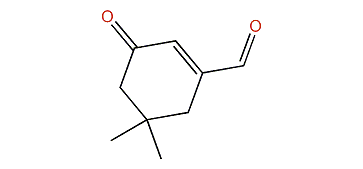
| 2,6,6-Trimethylcyclohex-2-ene-1,4-dione |
| Formula: | C9H12O2 |
| CAS#: | 1125-21-9 |
| MW: | 152.19 |
[MS]
[ NMR ]
[ Kovats ]
[ Synthesis ]
[Occurrence in flower]
|
|
Species utilize 2,6,6-Trimethylcyclohex-2-ene-1,4-dione in its chemical communication system
| Aplousobranchia, Polyclinidae | |
| Amaroucium pliciferum |
P
�Category of the chemical signal
| A - | Attractant |
| Al - | Allomone |
| K - | Kairomone |
| P - | Pheromone |
| Sy - | Synomone� |
|
�(*) indicates that compound is active�
|
|
| |
| Lepidoptera, Danaidae, Danainae | |
| Amauris echeria |
P
�Category of the chemical signal
| A - | Attractant |
| Al - | Allomone |
| K - | Kairomone |
| P - | Pheromone |
| Sy - | Synomone� |
|
�(*) indicates that compound is active�
|
Chief |
| |
| Lepidoptera, Nymphalidae, Heliconiinae | |
| Aglais urticae |
A
�Category of the chemical signal
| A - | Attractant |
| Al - | Allomone |
| K - | Kairomone |
| P - | Pheromone |
| Sy - | Synomone� |
|
�(*) indicates that compound is active�
|
Small tortoiseshell |
| |
| Hymenoptera, Formicidae, Formicinae, Camponotini | |
| Camponotus pilicornis |
A
�Category of the chemical signal
| A - | Attractant |
| Al - | Allomone |
| K - | Kairomone |
| P - | Pheromone |
| Sy - | Synomone� |
|
�(*) indicates that compound is active�
|
|
| |
| Hymenoptera, Formicidae, Formicinae, Plagiolepidini | |
| Plagiolepis pygmaea |
A
�Category of the chemical signal
| A - | Attractant |
| Al - | Allomone |
| K - | Kairomone |
| P - | Pheromone |
| Sy - | Synomone� |
|
�(*) indicates that compound is active�
|
|
| |
| Hymenoptera, Formicidae, Myrmicinae, Crematogastrini | |
| Crematogaster auberti |
A
�Category of the chemical signal
| A - | Attractant |
| Al - | Allomone |
| K - | Kairomone |
| P - | Pheromone |
| Sy - | Synomone� |
|
�(*) indicates that compound is active�
|
|
| Crematogaster scutellaris |
A
�Category of the chemical signal
| A - | Attractant |
| Al - | Allomone |
| K - | Kairomone |
| P - | Pheromone |
| Sy - | Synomone� |
|
�(*) indicates that compound is active�
|
Red-headed ant |
| |
| Hymenoptera, Formicidae, Myrmicinae, Pheidolini | |
| Aphaenogaster senilis |
A
�Category of the chemical signal
| A - | Attractant |
| Al - | Allomone |
| K - | Kairomone |
| P - | Pheromone |
| Sy - | Synomone� |
|
�(*) indicates that compound is active�
|
|
| Pheidole pallidula |
A
�Category of the chemical signal
| A - | Attractant |
| Al - | Allomone |
| K - | Kairomone |
| P - | Pheromone |
| Sy - | Synomone� |
|
�(*) indicates that compound is active�
|
|
| |
| Hymenoptera, Formicidae, Myrmicinae, Tetramoriini | |
| Tetramorium semilaeve |
A
�Category of the chemical signal
| A - | Attractant |
| Al - | Allomone |
| K - | Kairomone |
| P - | Pheromone |
| Sy - | Synomone� |
|
�(*) indicates that compound is active�
|
|
| |
| Lepidoptera, Ithomiidae, Ithomiinae, Ithomiini | |
| Prittwitzia hymenaea |
P
�Category of the chemical signal
| A - | Attractant |
| Al - | Allomone |
| K - | Kairomone |
| P - | Pheromone |
| Sy - | Synomone� |
|
�(*) indicates that compound is active�
|
|
| |
| Lepidoptera, Nymphalidae, Nymphalinae, Nymphalini | |
| Inachis io |
A
�Category of the chemical signal
| A - | Attractant |
| Al - | Allomone |
| K - | Kairomone |
| P - | Pheromone |
| Sy - | Synomone� |
|
�(*) indicates that compound is active�
|
Peacock butterfly |
| |
| Lepidoptera, Pieridae, Coliadinae, Gonepterygini | |
| Gonepteryx rhamni |
A
�Category of the chemical signal
| A - | Attractant |
| Al - | Allomone |
| K - | Kairomone |
| P - | Pheromone |
| Sy - | Synomone� |
|
�(*) indicates that compound is active�
|
Common brimstone |
| |
| Orthoptera, Romaleidae, Romaleinae, Romaleini | |
| Romalea microptera |
Al
�Category of the chemical signal
| A - | Attractant |
| Al - | Allomone |
| K - | Kairomone |
| P - | Pheromone |
| Sy - | Synomone� |
|
�(*) indicates that compound is active�
|
Eastern lubber grasshopper |
| |
|







